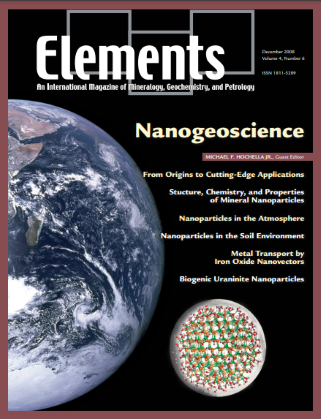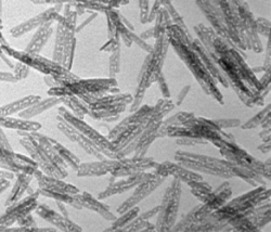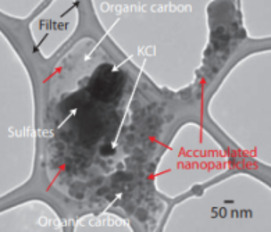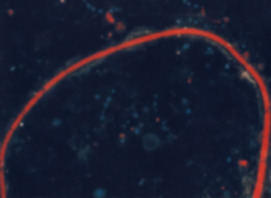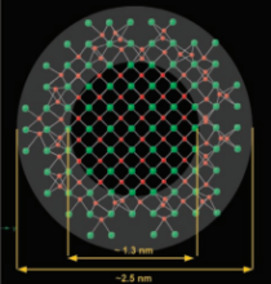
Nanogeoscience
Michael F. Hochella, Jr. – Guest Editors
Table of Contents
At first glance, nano and Earth seem about as far apart as one can imagine. Nanogeo- science seems to be a word connecting oppo- sites. More specifically, a nanometer relative to a meter is the same as a marble relative to the size of this planet. But to a growing num- ber of Earth scientists, the term nanogeo- science makes perfect sense. Nanomaterials can be manufactured, but they are also nat- urally occurring. In fact, we now think that nanomaterials are essentially ubiquitous in nature. Importantly, nanomaterials often have dramatically different properties from those of the same material with larger grain size. By understanding these property changes as a function of size and shape in the nanorange, we will acquire another perspective from which to view Earth chemistry. This issue of Elements will explore our cur- rent knowledge of nanogeoscience using numerous examples from the “critical zone” of the Earth, as well as from the oceans and the atmosphere. Important insights into local, regional, and even global phenomena await our understanding of processes that are relevant at the smallest scales of Earth science studies. Nanogeoscience is at a relatively early stage of development. Therefore, large gaps in our knowledge in this area exist, making the next few years and decades an exciting time of new real- izations, discovery, and change. This issue of Elements will help promote and ener- gize this field in its early adolescence.
Nanogeoscience: From Origins to Cutting-Edge Applications
Structure, Chemistry, and Properties of Mineral Nanoparticles
Nanoparticles in the Atmosphere
Nanoparticles in the Soil Environment
Iron Oxides as Geochemical Nanovectors for Metal Transport in Soil–River Systems
Biogenic Uraninite Nanoparticles and Their Importance for Uranium Remediation
Activation Laboratories (Actlabs)
Advanced Energy Consortium (AEC)
Australian Scientific Instruments (ASI)
Bruker AXS
CAMECA
Excalibur Mineral Corporation
Hudson Institute of Mineralogy
Meiji Techno America
Rigaku
RockWare
Smart Elements
Thermo Scientific (Part of Thermo Fisher Scientific)
v5n1 Scientific Exploration of the Moon
Guest editor: John W. Delano (University at Albany, State University of New york)
Our current understanding of the Moon’s history, interior structure, and chemical composition is based in large part on geochemical data acquired from samples from the U.S. Apollo and Soviet Luna missions; data acquired by Apollo geo physical instruments; orbital geochemi cal and spectral data acquired by robotic missions from the U.S., Japan, and Chi na; analysis of lunar meteorites derived from previously unsampled regions of the Moon; and Earthbased radar obser vations and infrared spectral reflectance data. All of these efforts have contribut ed to a preliminary understanding of the origin of the Moon and the process es that have affected its surface and inte rior. Isotopic analyses of impactgener ated samples have placed constraints on the timedependent meteorite flux that not only affected the Moon but also the Earth and other objects in the inner solar system. In this issue of Elements, leading scientists discuss the major concepts that underpin our current understanding of the Moon, as well as scientific plans for international scientific exploration by robotic and human missions.
Scientific Exploration of the Moon John W. Delano (University at Albany, State University of New york)
- Ancient Lunar Crust: Origin, Composition, and Implications G. Jeffrey Taylor (University of Hawai’i)
- The Lunar Cataclysm: Reality or “Mythconception”? Marc D. Norman (Australian National University)
- Lunar Mare Volcanism: Where Did the Magmas Come From? Timothy L. Grove (Massachusetts Institute of Technology) and Michael J. Krawczynski
- The Interior Structure of the Moon: What Does Geophysics Have to Say? Mark A. Wieczorek (Institut de Physique du Globe de Paris)
- The Poles of the Moon Paul G. Lucey (University of Hawai’i)
- Supervolcanoes (February 2008)
- Phosphates and Global Sustainability (April 2008)
- Deep Earth and Mineral Physics (June 2008)
- Platinum-Group Elements (August 2008)
- Carbon Dioxide Sequestration (October 2008)
- Nanogeoscience (December 2008)
Download 2008 Thematic Preview
- Scientific Exploration of the Moon (February 2009)
- Bentonites – Versatile Clays (April 2009)
- Gems (June 2009)
- Mineral Magmatism: From Microbes to Meteorites (August 2009)
- Gold (October 2009)
- Metal Stable Isotopes: Signals in the Environment (December 2009)
Download 2009 Thematic Preview


